Beyond Prices and Quantities: Greening Policies Under Sectoral Reforms in Argentina
At a Glance
Key Challenge
Policy Insight
Introduction
The goal of building a sustainable energy supply is a worldwide challenge. Since the 2000s, most countries have enacted at least one policy aimed at decarbonizing the electricity sector. Yet, the extent to which these greening policies have led to a substantive penetration of renewable energy into the electricity supply mix has diverged across and within countries through time.
In response to initial failures, several governments have amended initial greening policies and adapted them to their national contexts.1 Argentina has followed this trend. The country promoted fiscal incentives and auctions to increase the share of solar and wind energies during the first decade of the 2000s, but these initiatives did not lead to a significant penetration of these technologies into their electricity mix.
During the second decade of the 2000s, Argentina promoted a second set of fiscal measures and auctions to develop green technologies. These policies proved to be more efficient in promoting the takeoff of solar and wind sources: in 2013, Argentina showed an electricity mix in which solar and wind sources accounted for less than 1% of the total; in 2020, the percentage added up to 8%.2
Why did initial policies in Argentina fail while subsequent policies succeeded? In contexts where public capital is scarce, private actors are the ones who take the risk of investing in renewable technologies. Governments in developing countries, therefore, need to provide clear incentives to ensure initial investments will be recovered with acceptable economic gains. Among these incentives are clear price signals on the profitability of the investment (Purkus et al. 2015) and the removal of entry barriers that favor incumbent generators (Iimura and Cross 2018; Nicolli and Vona 2019).
Traditional classifications on renewable energy policies—based on quantities or prices—are insufficient to understand all features of greening instruments. They do not capture how they relate to a country’s existing electricity sector.
In this digest, I differentiate between narrow and broad greening electricity policies by considering their framing within a broader reform of the electricity sector. Based on this distinction, I discuss how successful greening policies in Argentina occurred when they were implemented within broader reforms of the electricity sector.
Defining Greening Electricity Policies
Decarbonized electrification implies replacing electricity from coal, oil, and gas by electricity generated from non-fossil renewable sources. Among these technologies, solar and wind energies are the ones driving current transformations of electricity sectors. The deployment of these sources is inherently related to the adoption of greening electricity policies; that is, the set of policies and institutions that aim to increase the production and share of solar and wind sources in the electricity mix of a country.
These policies are usually classified in terms of the type of policy levers governments use (Breetz, Mildenberger, and Stokes 2018): altering the relative prices or quantities of clean energy. This classification, however, does not capture the fact that greening electricity policies are adopted in the context of electricity sectors with specific formal and informal rules that govern the generation, distribution, and consumption of electricity.
These rules establish different interest groups and affect the behavior of actors by changing their incentives towards specific technologies, thereby reinforcing carbon locked energy systems. Since established institutions create feedback effects (Pierson 1993, 2000) that tend to favor the status quo, greening electricity policies must alter these structures.
Greening policies can be placed into two categories depending on whether they are framed within a broader reform of the electricity market:
- Narrow Greening Policies. Instruments that promote the production of wind and solar energies by changing the relative prices or quantities of clean energy without affecting the institutional structure of the electricity sector of the country.
- Broad Greening Policies. Instruments that lever the prices and/or quantities of clean technologies while also addressing broader electricity sector reform.3
The content of broad reforms is endogenous to the characteristics of the electricity sector. Electricity sectors can be distinguished as liberalized and controlled, depending on the extent to which the state intervenes in the functioning of the market. In liberalized sectors, the state has a minor role in administrating the generation and distribution of electricity, which mainly depend on the incentives and investment decisions of private utilities. However, the absence of a central regulator can lead to an imperfect-competition context where a few utilities produce the whole supply of electricity that gets to end users (Pineau, Rasata, and Zaccour 2011).
A concentrated sector matters for the development of greening policies since it acts as a barrier for new suppliers of energy (Wolak 2003); and because oligopolies are biased against renewable energies and therefore invest in previous technologies that are cheaper for them (Beck and Martinot 2016). Under these circumstances, broad greening policies need to increase the incentives for solar and wind investment while deconcentrating the market to allow the entrance of new producers.
In controlled electricity sectors, governments usually use their regulatory power to manipulate electricity prices. Under a controlled regime, prices are not set in a competitive way and generators may have to sell energy at a price below market levels. Usually, these price cap regulations are accompanied by government subsidies to generators to make up for the harmful consequences of the price-cap (Commander 2012, 8).
Yet, the combination of price caps and subsidies may undermine energy providers’ incentives to invest in new infrastructure. Subsidies may encourage reliance on out-of-date and dirtier technologies and prevent new actors from investing in new cleaner sources. In such circumstances, broad reforms need to deregulate the sector and send consistent price signals to both incumbent and new utilities.
I rely on this conceptual framework to analyze the evolution of greening electricity policies in Argentina, a country in which the market-controlling reforms of the 1990s led to a deregulated and then controlled sector in the 2000s.
The Electricity Sector in Argentina
During the 1990s, Argentina underwent a profound series of market reforms that led to the privatization of the electricity sector. The market-controlling reform (Murillo 2009) started at the end of 1991.4 It established the unbundling of the sector; the conditions for transferring assets to private providers; the rules for entering each segment; and the regulatory authority.
While these reforms did not limit investment by foreign capital, they established rules for entry and investment requirements (Murillo and Finchelstein 2004; Pollitt 2008). The state retained a proactive role in controlling property concentration during and after the sale of privatized assets.
The dispatch of electricity was organized by CAMMESA5, an organization that includes all the actors of the electricity market and the Secretary of Energy, which has veto power. By the beginning of the 2000s the electricity market was competitive, and the generation of electricity was highly concentrated.6
Yet, the economic crisis of 2001-2002 altered the functionality of the electricity sector. In 2002, the country’s GDP shrank more than 10% and unemployment increased more than 5%. A devaluation of the currency of almost 230% and 40% of inflation in 2002 reduced the purchasing power of most of the population, forcing households to spend larger fractions of their income on basic services. To ameliorate these problems, the former president Eduardo Duhalde renegotiated all utilities—including electricity—and unilaterally froze the rates charged to consumers at pre-crisis levels.7
This trend continued under the presidency of the Néstor Kirchner, who assumed the role in May 2003 after having won with just 22% of the national vote. Concerned about his weak electoral position, Kirchner chose to maintain frozen tariffs for all consumers. By the mid 2000s, the electricity market in Argentina evolved as a controlled one. The Secretary of Energy became the central actor of the whole system: buying the fuels, producing electricity, distributing it to generators, setting price limits, and deciding the moment in which generators were paid.8
To maintain low electricity prices, Argentine governments spent billions of dollars in subsidies to generators to cover their costs.9 These subsidies put a lot of pressure on Argentine fiscal accounts, and led to a situation of late and lower payments to generators.10 In a context in which the government also restricted the exports of natural gas to guarantee the local supply11, producers decided to stop investing in new generation plants.12 Indeed, new investments in the electricity sector dropped from U.S. $1.8 billion in 2006 to U.S. $322 million in 2010 (World Bank 2021). Within this context, the country went from being a net exporter of natural gas to a net importer in 2010.
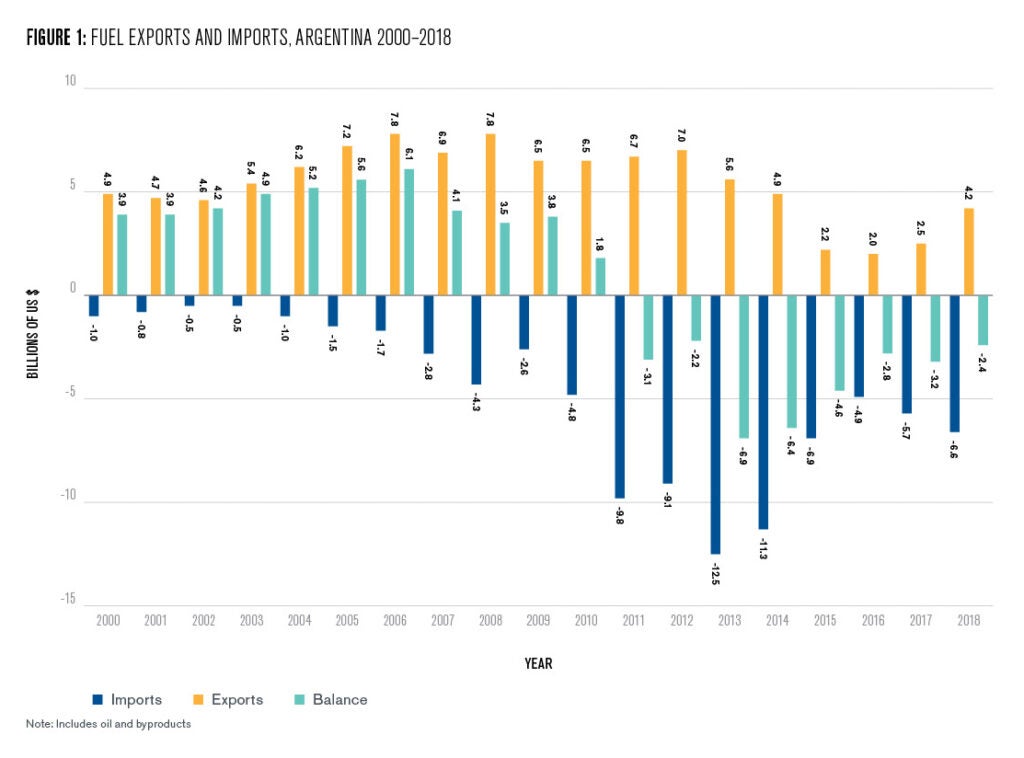
In a scenario of a high energy demand, limited energy supply, and high fiscal deficits due to energy imports, governments in Argentina decided to adopt greening policies to foster the production of solar and wind energies. Increasing the share of renewable energies, in this context, was framed as a way to have a smaller proportion of thermal sources to generate electricity, and thereby to increase private investments and reduce both the imports of natural gas and subsidies towards the generation of electricity from these sources.
Greening Policies in Argentina
Argentina approved a first law on renewable energies13 in 200614 and put it into force in 200915 by providing several fiscal incentives to generators and launching a set of auctions—called GenRen. These narrow measures did not have the expected results in terms of an increased production from renewable sources. The failure of such initiatives can be found in the institutional and political context surrounding them. Investors in Argentina pay attention to three things when making financial decisions: (1) the natural endowment, (2) the demand, and (3) the consistency of institutional rules.16
Within these three, Argentina lacked the third one. The bias of a policy against the electricity producers, given the combination of price regulations and the inability to finance sufficient subsidies for producers to cover the cost of regulated prices, hindered the chances of an effective takeoff of these technologies. Even if subsidies lowered the initial upfront costs of solar and wind energies, the uncertainty around the behavior of the government lowered the incentives of firms to start investments in new technologies.17
By the end of 201518, the government enacted a new law on renewable energies that was implemented in 201619 under the Renovar auctions. In front of the failure of the previous law, policymakers in Argentina implemented broader measures to deregulate the electricity sector.
This broad reform entailed three different measures: (1) the liberalization of electricity prices that proved to be a positive price signal for new investors;20 (2) the inclusion of contracts between generators and private actors without the intervention of the state;21 and (3) the institutionalization of external actors—e.g., the World Bank—as economic guarantees for generators to prevent late and discretional payments of the state.
In 2016, the recently inaugurated government led by the right-wing president Mauricio Macri (2015-2019) regulated and implemented the new law on renewable energies including broader reforms of the electricity sector, in which prices were liberalized to send a positive price signal for incumbent utilities and new investors.
By February 2016, the government increased the prices of electricity by almost 500%. This decision reflected the ideology of a government that wanted to develop clean energies while putting fiscal discipline and private investments at the top of its goals22, and the recognition that increasing prices would be electorally costly.
Knowing the electoral costs of liberalizing the prices, the government strategically decided to adopt them at the beginning of its term knowing that such measures could cause a popular rejection.23 In this case, the broad policy fostered the installment of new plants and increased the share of solar and wind energies to 8% of the total electricity generation in 2020.
Greening Policy Effects
This section analyzes the effect of narrow and broad policies in the electricity mix of Argentina, by using the Synthetic Control Method (SCM) (Abadie, Diamond, and Hainmueller 2010; Lepissier and Mildenberger 2021).24 By using a pool of donor countries, the SCM allows the creation of two synthetic Argentinas that serve as counterfactuals where the treatments never occurred. The resulting synthetic Argentinas reflect what Argentina might have experienced had it not adopted first the narrow and then the broad strategies that it did.
The donor pool is formed by democratic emerging countries for the period of 1990 to 2020. Donors are restricted to those countries that (a) have not implemented any narrow policy toward renewable energies three years before or after Argentina (2006); and (b) have not implemented any broad policy toward renewable energies three years before or after Argentina (2015).25 The synthetic Argentinas are based on the lagged values of the share of solar and wind energies over the total electricity generation mix, and lagged values of variables associated with the generation of renewable sources: GDP, CO2 emissions per capita, and the share of hydro and natural gas in the electricity mix.
Figure 2 shows the trends of Argentina and its synthetic counterparts considering the two policies as treatments and the share of solar and wind energies in the total electricity generation mix as the main outcome. During the pre-treatment periods, the differences in means between Argentina (black solid line) and the synthetic counterparts (red and blue lines) are statistically indistinguishable from zero. Almost immediately after the passage of the first law on renewable energies in 2006, there is deviance from the synthetic Argentina.
Yet, the effect seems to be negative, as the gap between the actual Argentina and its synthetic counterpart is less than zero and reaches a level of -0.96 by 2015. This result suggests that the narrow greening policy in Argentina was not successful in pushing a higher penetration of wind and solar energies in the mix, and if any, its effect was negative.
Alternatively, the effect of the broad greening policy appears to be positive and substantive. The country shows an increase in the share of the solar and wind energies after the law 27,191 was adopted. The effect seen in the figure seems to be important as it deviates quite notably after the treatment period. By 2020 the gap between the actual Argentina and its counterpart is 7.29, meaning that Argentina showed a fraction of total energy generation from solar and wind that was 7.29 percentage points higher than in the control group.

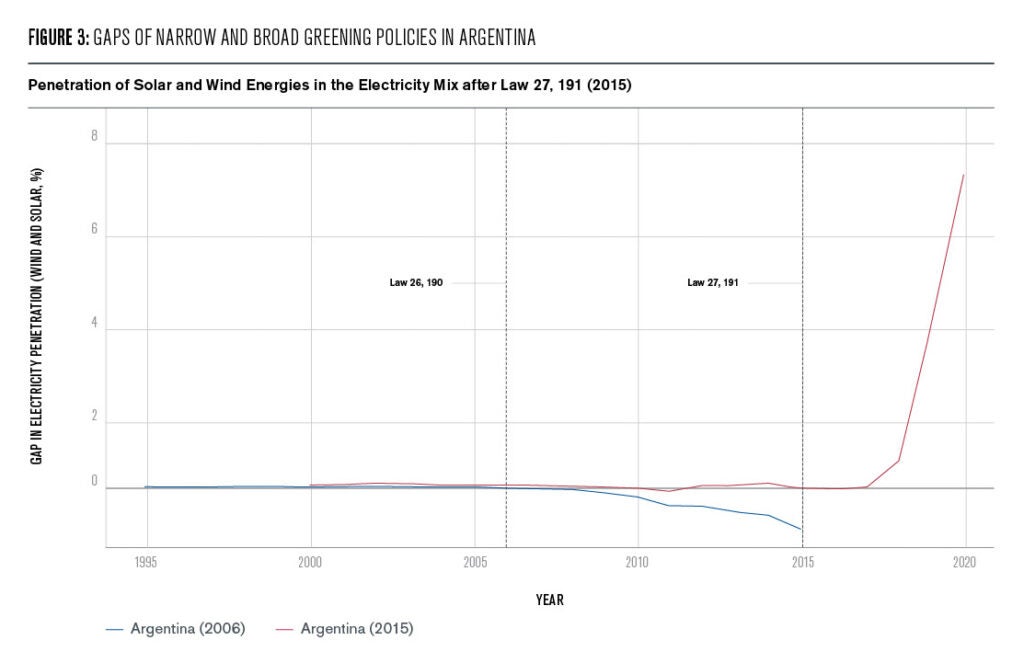
To assess if these estimates are significant, figure 4 shows the results of a series of placebo studies by iteratively applying the SCM to estimate the effect of the treatments in every country in the donor pool. In other words, the placebo studies create synthetic controls for each of these countries and estimate the relative breaks after 2006 and after 2015. The grey lines show the placebo countries, while the black line represents Argentina, the actual treated country.
Considering the placebo test, the causal effect of the narrow policy of 2006 is statistically insignificant (p-value = 0.56), meaning that this measure had a null effect on pushing a higher penetration of wind and solar energies in the mix. Yet, considering the enactment of the broad policy in 2015, Argentina’s trajectory is the most unusual one (p-value = 0.08). In other words, this result suggests that the evolution of solar and wind energies in Argentina was not random.
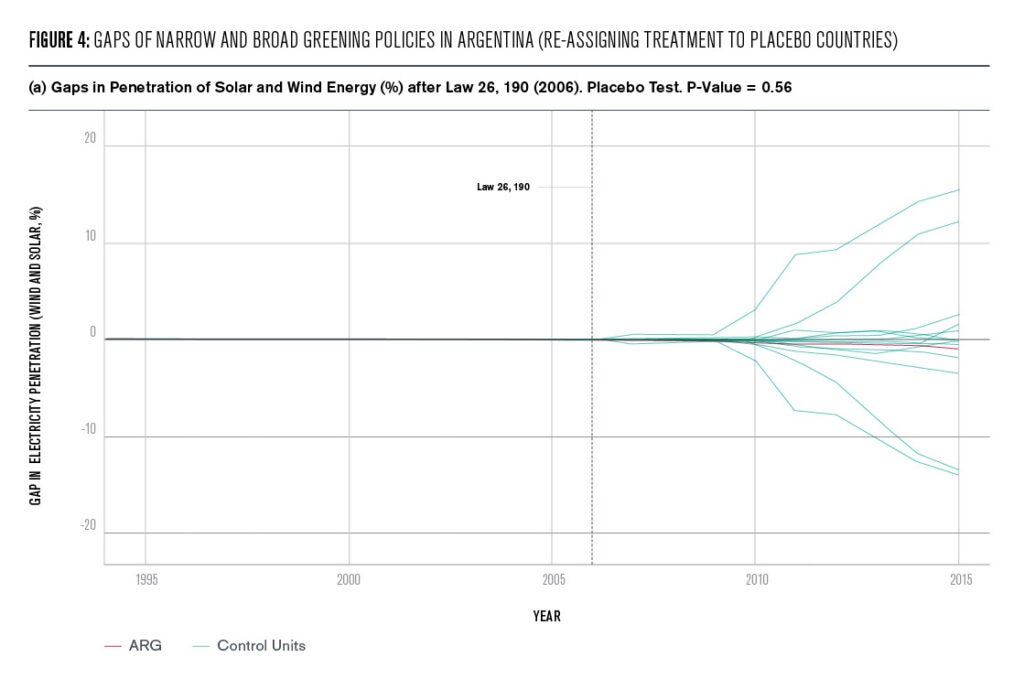
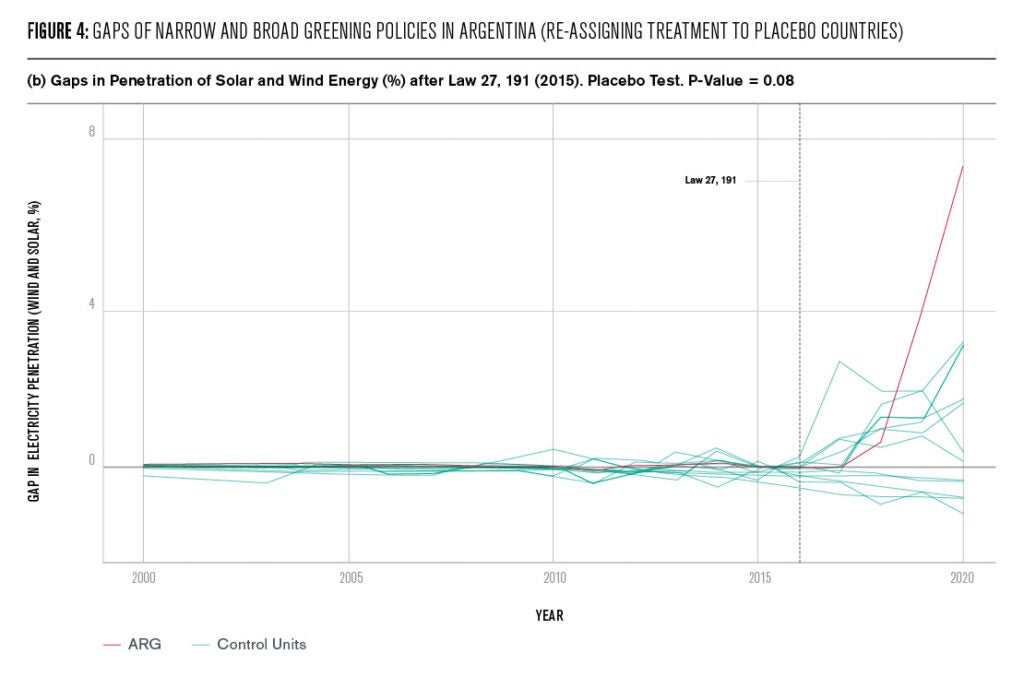
Additional robustness tests for the second treatment are shown in figures 5 to 7. Figure 5 displays a placebo “in time” test, where the treatment is established two years before the actual treatment. The trajectory of the synthetic control for the placebo years 2013-2015 do not start diverging from those of Argentina until after 2017 and not earlier.
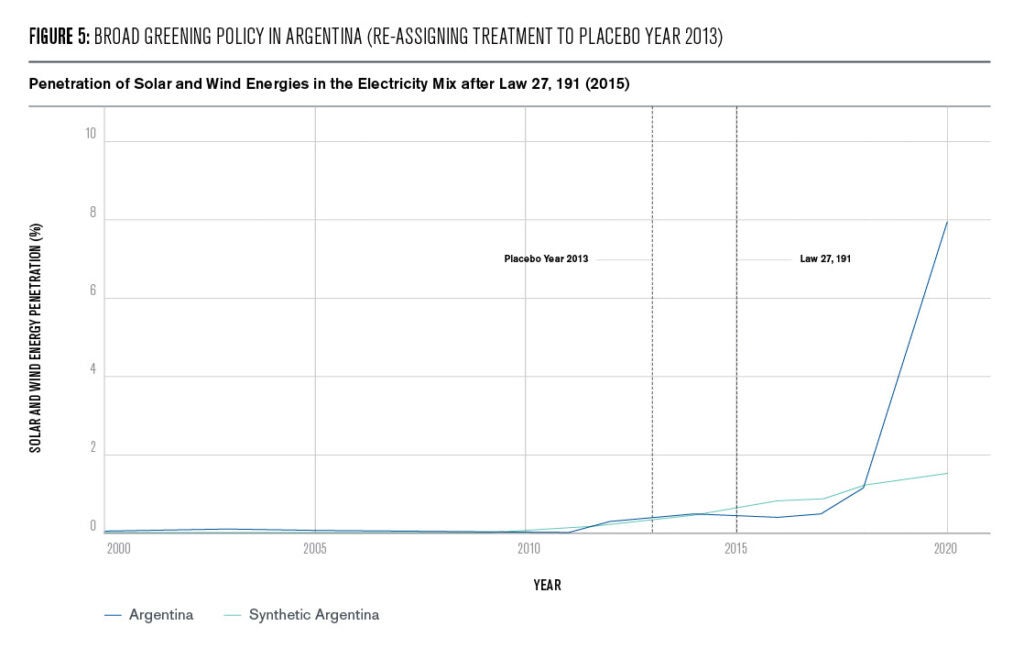
Figure 6 shows the results with an alternative sample for the donor pool, comprised only by Latin American countries. Restricting the donor pool is not a problem: the treatment effect is comparable (6.6%) and is statistically significant (p-value = 0.1). Finally, figure 7 displays the results of a “leave-one-out” robustness check where every single country is iteratively dropped at a time from the donor pool. The results remain significant after dropping each unit from the pool.
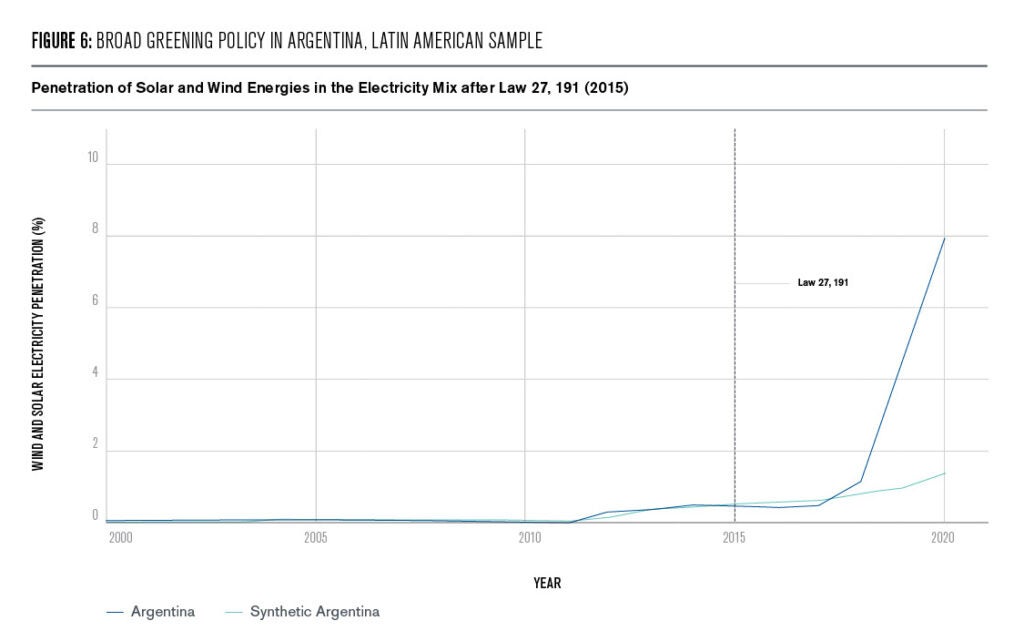
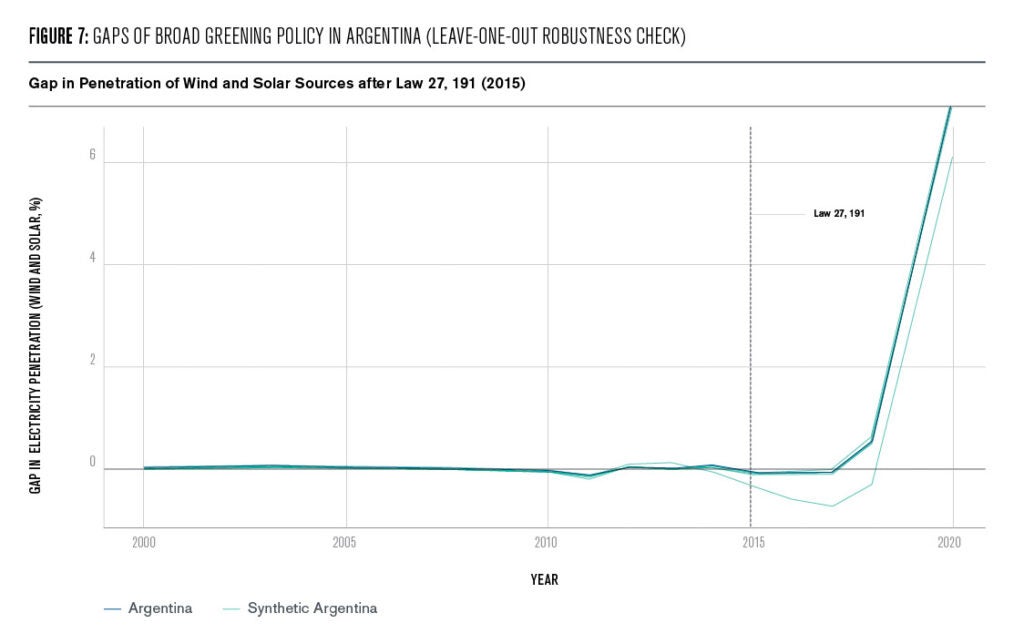
Overall, the SCM results show that only those policies that were implemented in parallel to additional reforms of the electricity sector led to significant penetration of renewable energies in the mix of the country.
Final Remarks
Greening policies are not implemented in an institutional vacuum. As it happens with all processes of creative destruction (Schumpeter 2008 [1942]), institutional environment matters for making investments. The latter because institutions can affect the extent to which individuals decide to incur costs in the present to gain (economic) benefits in the future.
The performance of the policy usually depends on both its design and the broader institutional and economic environments of the country (Recalde 2016). Even if technologies reduce the cost of generation26, political and institutional barriers still need to be removed to promote an effective penetration of renewable sources in the electricity sector.
Among these barriers, the institutional design of the electricity sector is a dimension usually absent in the literature on energy politics, that needs to be considered to understand the success (or failure) of greening policies. The Argentine case provides suggestive evidence that effective instruments need to be accompanied by additional measures that change sectoral rules that incentivize the status quo.
This analysis stresses how previous reforms of the electricity sector shape the content of the broad greening policies. Policymakers in countries with scarce resources, therefore, should consider policy mixes that provide clear incentives to new producers by decreasing the initial costs of the technologies and by building rules that increase institutional trust.
The adoption of such reforms, however, can prove to be costly for politicians. The institutional design of the electricity sector does not only alter the incentives of actors, but also establishes certain interest groups. The decision to adopt a broad greening policy, in this sense, may mobilize these interest groups that want to block policy change. While narrow greening policies have low costs for the whole spectrum of actors—given that they are less visible and focus on positive economic and environmental incentives—broad greening policies are wicked distributive decisions that aim at changing the status quo in the short term.
In Argentina, the adoption of broad policies in 2016 entailed a substantial increase in the prices of electricity. Most of the costs of the reforms were suffered by households, who mobilized against them. Politicians, in this sense, had to decide when to adopt such measures to reduce their potential costs. The decision of the former President Macri to implement the reforms at the beginning of his government cycle can be interpreted as a strategy to ameliorate their electoral costs.
Future research will delve into the drivers of broad greening policies, by focusing on how political and ideological factors shape both the content and timing of the reform.

Santiago Cunial
Abadie, Alberto, Alexis Diamond, and Jens Hainmueller. 2010. “Synthetic Control Methods for Comparative Case Studies: Estimating the Effect of California’s Tobacco Control Program.” Journal of the American Statistical Association 105 (490): 493-505.
Beck, Fred, and Eric Martinot. 2016. “Renewable Energy Policies and Barriers.”
Breetz, Hanna, Matto Mildenberger, and Leah Stokes. 2018. “The Political Logics of Clean Energy Transitions.” Business and Politics 20 (4): 492-522.
Commander, Simon. 2012. A Guide to the Political Economy of Reforming Energy Subsidies. IZA Policy paper.
Einstoss, Alejandro. 2020. Precios, tarifas y subsidios a la energía. El problema de la regulación energética 2003-2019. Buenos Aires: EUDEBA.
IEA. 2020. “Data and Statistics.” https://www.iea.org/data-and-statistics?country=CHILE&fuel=Electricity%20and%20heat&indicator=ElecGenByFuel.
Iimura, Akiko, and Jeffrey S. Cross. 2018. “The Impact of Renewable Energy on Household Electricity Prices in Liberalized Electricity Markets: A Cross-National Panel Data Analysis.” Utilities Policy 54: 96-106. https://doi.org/10.1016/j.jup.2018.08.003. https://dx.doi.org/10.1016/j.jup.2018.08.003.
Lazard. 2020. Lazard’s Levelized Cost of Energy Analysis. Version 14.0. https://www.lazard.com/media/451419/lazards-levelized-cost-of-energy-version-140.pdf.
Lépissier, Alice, and Matto Mildenberger. “Unilateral climate policies can substantially reduce national carbon pollution.” Climatic Change 166.3 (2021): 1-21.
Ministry of Finance of Argentina. 2020. “National Budget per Year.” https://www.argentina.gob.ar/economia/transparencia/presupuesto.
Murillo, Maria Victoria. 2009. Political Competition, Partisanship, and Policy Making in Latin American Public Utilities. Cambridge University Press.
Murillo, Maria Victoria, and Diego Finchelstein. 2004. “Privatizacion y poder de mercado: el caso de la generación de energía eléctrica en la Argentina.” Desarrollo económico: 131-144.
Nhamo, Godwell, and Chipo Mukonza. 2016. “Policy, Institutional and Programme Readiness for Solar Energy Uptake in South Africa.” Africa Insight 45 (4): 69-90.
Nicolli, Francesco, and Francesco Vona. 2019. “Energy Market Liberalization and Renewable Energy Policies in OECD Countries.” Energy Policy 128: 853-867.
Pacheco, Máximo. 2018. “Revolución energética en Chile.” Santiago de Chile: Ediciones UDP.
Página 12. 02/26/2019. “Cortes y marchas contra los tarifazos.” 02/26/2019. Accessed 02/20/2021. https://www.pagina12.com.ar/177440-cortes-y-marchas-contra-los-tarifazos.
Personal Interview. 01/07/2021. Former Secretary of Energy of Argentina.
—. 01/19/2021. Representative of firm specialized in thermal and wind energies in Argentina.
—. 01/20/2021. Representative of firm specialized in thermal and wind energies in Argentina.
—. 02/01/2021. Former president of CAMMESA.
—. 02/18/2021. Legal representative of energy firms in Argentina.
—. 02/23/2021a. Representative of CAMMESA.
—. 02/23/2021b. Representative of firm specialized in thermal, wind, and solar energies in Argentina.
—. 03/05/2021. Representative of firm specialized in thermal and wind energies in Argentina.
—. 06/24/2020. Former Secretary of Renewable Energies of Argentina.
—. 12/23/2020. Representative of firm specialized in thermal energies in Argentina.
Pierson, Paul. 1993. “When Effect Becomes Cause: Policy Feedback and Political Change.” World Politics 45 (4): 595-628.
—. 2000. “Increasing Returns, Path Dependence, and the Study of Politics.” American Political Science Review: 251-267.
Pineau, Pierre-Olivier, Hasina Rasata, and Georges Zaccour. 2011. “A Dynamic Oligopolistic Electricity Market with Interdependent Market Segments.” The Energy Journal 32 (4): 183-217. http://www.jstor.org/stable/41323338.
Pollitt, Michael. 2008. “Electricity Reform in Argentina: Lessons for Developing Countries.” Energy Economics 30 (4): 1536-1567.
Presidencia de la Nación Argentina. 2002. Decreto 50/2002: Obsérvase en su totalidad el Proyecto de Ley registrado bajo el N° 25,544.
—. 2015. Argentine Government Goals, 2015.
Purkus, Alexandra, Erik Gawel, Marc Deissenroth, Kristina Nienhaus, and Sandra Wassermann. 2015. “Market Integration of Renewable Energies Through Direct Marketing: Lessons Learned from the German Market Premium Scheme.” Energy, Sustainability and Society 5 (1). https://doi.org/10.1186/s13705-015-0040-1. https://dx.doi.org/10.1186/s13705-015-0040-1.
Recalde, Marina Yesica. 2016. “The Different Paths for Renewable Energies in Latin American Countries: The Relevance of the Enabling Frameworks and the Design of Instruments.” Wiley Interdisciplinary Reviews: Energy and Environment 5 (3): 305-326.
Schumpeter, Joseph. 2008 [1942]. Capitalism, Socialism, and Democracy. New York: Harper and Brothers.
Unruh, Gregory C. 2000. “Understanding Carbon Lock-In.” Energy policy 28 (12): 817-830.
Wolak, Frank A. 2003. “Measuring Unilateral Market Power in Wholesale Electricity Markets: The California Market, 1998-2000.” American Economic Review 93 (2): 425-430.
- Examples of this are South Africa (Nhamo and Mukonza 2016) and Chile (Pacheco 2018). [↩]
- Argentina ranked fourth in terms of share of solar and wind energies in the electricity mix among Latin American countries in 2020. Uruguay (43%), Chile (19%), and Brazil (10%) were the three countries with the highest share of solar and wind electricity in the region. [↩]
- It is also possible to think of electricity reforms that change the institutional framework of the sector, but without addressing the production of renewable energy sources. Yet, since these reforms are not directed to increase renewable energy, they are not framed as greening policies. [↩]
- Law 24,065. [↩]
- CAMMESA (Compañía Administradora del Mercado Eléctrico Mayorista Sociedad Anonima) is a private entity, 20% of which is owned by the Argentine State and the rest of the equity is held by representative entities of members of the wholesale electricity market: transmission utilities, distribution companies, generators, and large users. [↩]
- The Herfindahl Hirshman Index of concentration (HHI) in the generation market was 708 points in 2002 (Pollitt 2008, 1544). [↩]
- Decree 50/2002. [↩]
- Personal Interview (02/18/2021, 03/05/2021). [↩]
- The recovery costs of generators -that is, the cost of generation covered by electricity prices- went down from 98% in 2002 to 14.5% in 2015 (Einstoss 2020, 144). Between 2011 and 2015, subsidies to the energy sector accounted for more than 36,000 million dollars (Ministry of Finance of Argentina 2020). [↩]
- Subsidies partially covered operational costs (Personal Interview 02/18/2021, 02/23/2021a, 03/05/2021), and payments from CAMMESA to generators were delayed up to 180 days (Personal Interview 01/07/2021, 02/23/2021b, 02/23/2021a, 03/05/2021). [↩]
- Resolution 265/2004 of the Secretary of Energy. [↩]
- In a context where prices departed from long-run sustainable opportunity costs for the investors, producers decided to reduce their investments in new generation plants and even in the maintenance of the installed ones. According to CAMMESA, during the period 2006-2015, the growth of electricity demand was close to doubling that of new installed capacity. [↩]
- Argentina also sanctioned a law on renewable energies in 1998, that was regulated in 1999. However, because of the economic crisis of 2001-2002, its implementation was truncated. [↩]
- Law 26,190 on Renewable Energies. [↩]
- Decree 562/2009. [↩]
- Personal Interview (01/19/2021, 01/20/2021, 02/01/2021). [↩]
- Personal Interview (01/19/2021, 06/24/2020, 12/23/2020). [↩]
- Law 27,191 on Renewable Energies. [↩]
- Decree 531/2016. [↩]
- Resolution 41/2016 of the Secretary of Electricity. [↩]
- Resolution 281-E/2017 of the Secretary of Electricity. [↩]
- Presidencia de la Nación Argentina (2015). [↩]
- Indeed, the increase in prices led to the mobilization of consumers (Página 12 02/26/2019). [↩]
- In the analysis that follows, I borrow the empirical strategy of Lepissier and Mildenberger (2021). [↩]
- The synthetic Argentina for the Law 26,190 enacted in 2006 is estimated using a blend compounded by Colombia (46.4%), South Africa (34.9%), Armenia (4.7%), Peru (3.2%), Costa Rica (2.3%), and Guatemala (2%). Alternatively, the synthetic Argentina for the Law 27,191 enacted in 2015 is estimated using a mixture of mainly Indonesia (54.8%), Slovenia (21.4%), and Colombia (21.2%). The fact that countries like Indonesia, Slovenia, and South Africa are part of the top donors, suggests that there were latent, unobserved forces driving Argentina’s renewable energies’ trend emissions, and that a weighted combination of these forces was found in the donor countries. [↩]
- Data on levelized costs of energy show that solar and wind energies became competitive against natural gas and other traditional fuels by 2010 (Lazard 2020). Yet, by 2020 the penetration of such sources in the electricity mix in developing countries is still limited (IEA 2020). [↩]